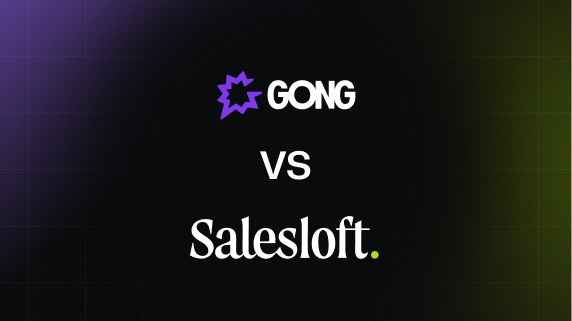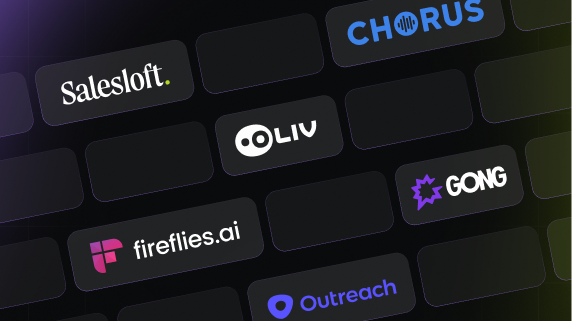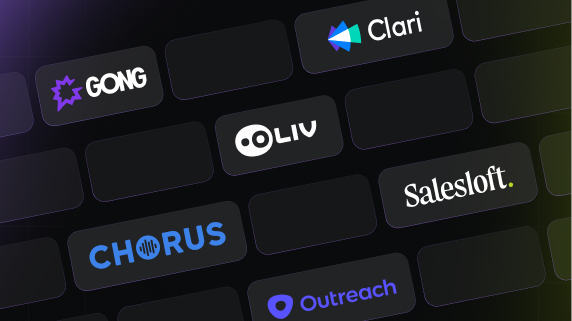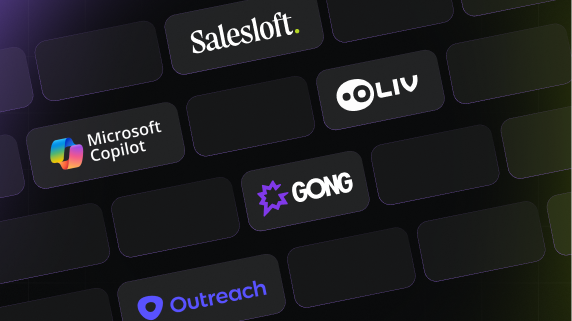What Are the Key Differences Between Gong and Salesloft in 2025? [toc=Key Differences]
Understanding the fundamental differences between Gong and Salesloft is crucial for revenue leaders evaluating their next sales technology investment. These platforms represent two distinct approaches to sales acceleration - Gong positioning itself as a revenue intelligence platform focused on conversation analytics, while Salesloft operates as a sales engagement platform emphasizing outbound prospecting and cadence management. However, both solutions were built in the previous decade using pre-generative AI technology, creating significant operational challenges for modern sales teams.
Traditional revenue intelligence and sales engagement platforms like Gong and Salesloft require extensive manual configuration, ongoing maintenance, and significant user adoption efforts. Gong excels in conversation intelligence but struggles with sales engagement, while Salesloft dominates cadence management but offers virtually no meaningful conversation intelligence or forecasting capabilities. This fragmentation forces revenue teams to maintain multiple tools, creating data silos and workflow inefficiencies that reduce productivity. Teams often spend more time managing these platforms than actually selling, with implementation timelines stretching 6-12 months and requiring dedicated RevOps resources.
The generative AI era has fundamentally transformed how revenue teams can approach sales technology. Modern AI-native platforms eliminate the need for separate conversation intelligence and sales engagement tools by providing unified, intelligent workflows that adapt to each team's unique processes. Instead of requiring users to learn complex interfaces and manual processes, generative AI performs the analytical work automatically, delivering actionable insights and executing tasks proactively. This shift from reactive dashboards to proactive intelligence represents a paradigm change in sales technology.
We've built Oliv.ai as a generative AI-native platform that unifies conversation intelligence, sales engagement, and revenue forecasting into a single agentic solution. Our Meeting Assistant automatically captures and analyzes every customer interaction without requiring setup or configuration, while our Prospector Agent conducts deep account research and creates personalized outreach sequences that achieve 3x higher response rates than traditional cadence-based approaches. The CRM Manager agent eliminates manual data entry by automatically updating deal records and enriching contact information in real-time.
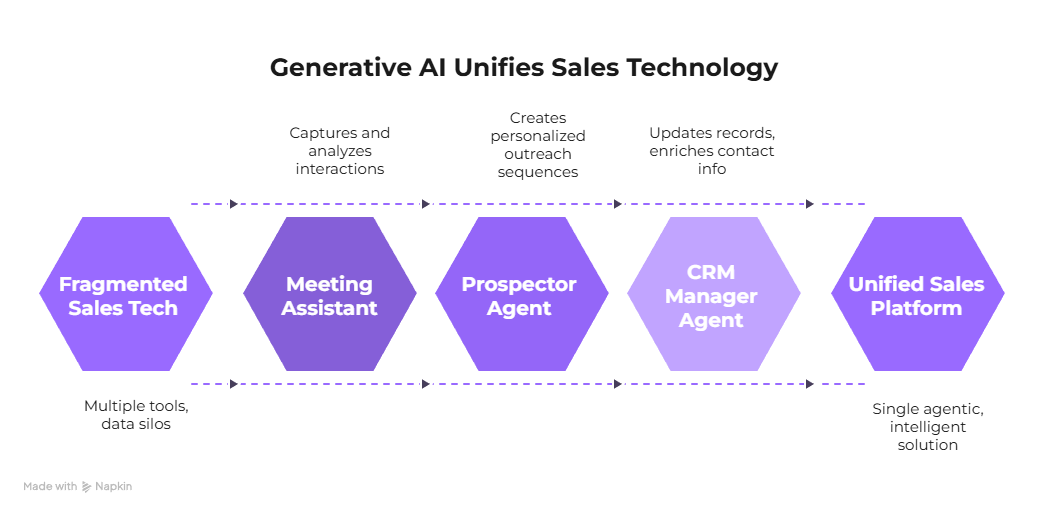
A recent enterprise client eliminated their Gong and Salesloft subscriptions after implementing Oliv, reducing their sales technology costs by 60% while improving deal velocity by 34%. Their VP of Sales noted, "Instead of training our team on two complex platforms, Oliv's agents simply do the work for us. Our reps focus on selling, not managing software." This represents the fundamental shift from traditional SaaS tools that require user adoption to agentic AI that performs work autonomously.
How Do Gong and Salesloft Compare for Conversation Intelligence in 2025? [toc=Conversation Intelligence]
Conversation intelligence serves as the foundation for modern revenue operations, transforming raw customer interactions into actionable insights that drive deal progression and coaching effectiveness. The quality of conversation intelligence directly impacts forecast accuracy, deal velocity, and sales team performance. Yet most sales leaders struggle with conversation intelligence tools that require extensive manual review and provide limited actionable insights, creating bottlenecks in their revenue operations.
Gong established itself as a conversation intelligence leader during the previous decade, offering comprehensive call recording and basic analytics capabilities. However, its pre-generative AI architecture requires significant manual effort to extract meaningful insights, with users spending hours reviewing dashboards and call summaries. Salesloft's conversation intelligence capabilities are fundamentally limited, working primarily for calls made through their platform and providing minimal analytical depth. Both platforms generate static reports that require manual interpretation, forcing sales managers to become data analysts rather than coaches.
Generative AI has revolutionized conversation intelligence by enabling real-time analysis, automated insight generation, and proactive recommendations. Modern AI can understand context, sentiment, and intent at a level that surpasses traditional keyword tracking and sentiment scoring. This technology transforms conversation intelligence from a reactive reporting tool into a proactive coaching and deal progression system that identifies risks and opportunities automatically.
Our Meeting Assistant agent represents the next generation of conversation intelligence, automatically analyzing every customer interaction and providing immediate, actionable insights without requiring manual review. The agent identifies deal risks, coaching opportunities, and next steps in real-time, while our Deal Driver agent proactively flags deals requiring attention with specific recommendations for advancement. Unlike traditional tools that generate reports, our agents take action - automatically updating CRM records, scheduling follow-ups, and creating personalized outreach sequences.
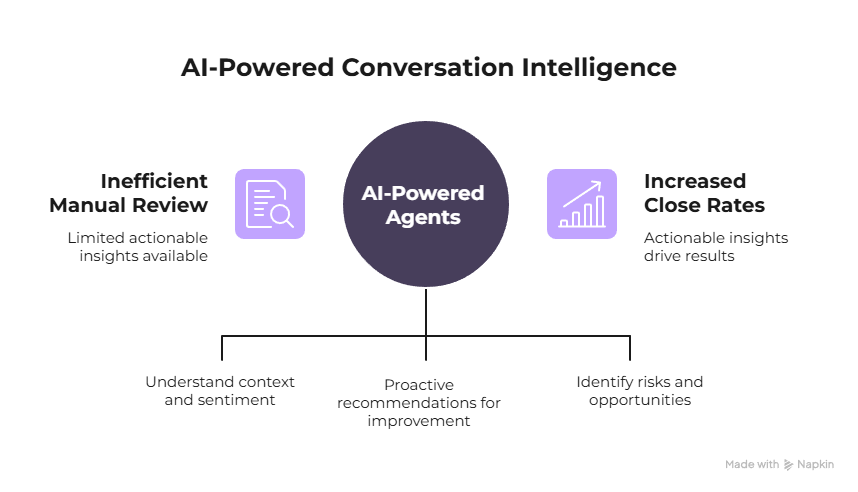
Recent analysis of over 10,000 sales calls processed through our platform shows that teams using Oliv's conversation intelligence achieve 23% higher close rates compared to traditional conversation intelligence tools. The difference lies in our agentic approach - instead of presenting data for human analysis, our agents provide specific, actionable recommendations that drive immediate results. As one sales director explained, "Oliv doesn't just tell us what happened on calls - it tells us exactly what to do next."
Which Platform Offers Better Sales Engagement Capabilities? [toc=Sales Engagement]
Sales engagement has evolved beyond mass email sequences and generic cadences to personalized, research-driven communication strategies that create meaningful buyer connections. Modern buyers expect relevant, timely outreach that demonstrates understanding of their specific challenges and priorities. This shift requires sales engagement platforms that can conduct deep research, craft personalized messaging, and time outreach based on buyer behavior - capabilities that fundamentally challenge traditional cadence-based approaches.
Salesloft built its reputation on sales engagement through automated sequencing and dialing capabilities, excelling at managing high-volume outreach campaigns for BDR teams. However, its approach remains rooted in mass, non-personalized prospecting that increasingly fails in today's buyer environment. Gong's Engage product faces significant adoption challenges and user experience issues, making it unsuitable for serious sales engagement efforts. Both platforms operate on the premise that quantity trumps quality, a philosophy that no longer drives results in the current market.
The era of bulk emailing and generic cadences has ended, replaced by AI-powered personalization that enables true account-based selling at scale. Modern sales engagement requires deep account research, personalized messaging, and intelligent timing - capabilities that generative AI delivers automatically. This technology enables sales teams to create truly personalized outreach sequences that resonate with individual buyers while maintaining the efficiency of automated workflows, addressing key meeting challenges that traditional tools cannot solve.
Our Prospector Agent revolutionizes sales engagement by conducting comprehensive account research, building customized account plans, and creating personalized messages that drive 3x higher response rates than traditional sequencing approaches. The agent analyzes company news, financial reports, recent hires, and technology stack changes to identify relevant conversation starters and pain points. Unlike traditional sales engagement platforms that focus on email volume, our approach prioritizes message relevance and timing, supporting advanced methodologies like MEDDIC and SPICED frameworks.
.png)
A recent analysis of 50,000 outreach attempts shows that personalized messages created by our Prospector Agent achieve 34% response rates compared to 8% for generic Salesloft sequences. The agent's ability to connect disparate data points and create relevant, personalized messaging represents a fundamental advancement beyond traditional sales engagement platforms. As one sales leader noted, "Our BDRs went from sending 100 generic emails to sending 20 highly personalized messages that actually get responses."
What's the Complete Feature-by-Feature Breakdown: Gong vs Salesloft vs Oliv? [toc=Feature Breakdown]
Granular feature evaluation represents the critical decision point where revenue teams move from vendor consideration to platform selection. The complexity of modern sales technology stacks demands thorough analysis of specific capabilities across transcription, conversation intelligence, automation, security, and revenue intelligence functions. This comprehensive comparison reveals how traditional pre-generative AI platforms like Gong and Salesloft address individual features, while exposing the fundamental limitations that drive teams toward modern alternatives.
Traditional revenue intelligence and sales engagement platforms built in the previous decade excel in isolated feature areas but struggle with unified functionality. Gong dominates conversation intelligence but lacks meaningful sales engagement capabilities, while Salesloft provides strong cadence management but offers virtually no conversation intelligence depth. This fragmentation forces revenue teams to maintain multiple tools, creating data silos and workflow inefficiencies.
George P., Sr Director, Franchise Sales, captures this frustration: "Phone calls - The default setting is the office phone number. The user does not have the ability to set the mobile number as the default... If you have a call with a prospect that is not interested or not now and your remove them from the Cadence, the system will not allow you to send a follow-up email." G2 Review
Generative AI has fundamentally transformed feature development by enabling unified, intelligent capabilities that eliminate the need for specialized point solutions. Modern AI-native platforms provide comprehensive functionality through intelligent agents that understand context, automate workflows, and deliver proactive insights. This shift enables revenue teams to access enterprise-grade capabilities without the complexity and training requirements of traditional SaaS software.
We've architected Oliv.ai as a generative AI-native platform that consolidates all critical revenue intelligence features into intelligent agents that perform work autonomously. Our comprehensive feature set eliminates the need for multiple tools while providing superior capabilities through agentic intelligence that adapts to each team's unique processes and requirements.
Transcription & Recording Capabilities Comparison
Verified User in Professional Training & Coaching highlights Salesloft's fundamental limitation: "Conversations doesn't work at all. They sell it as a gong competitor. It doesn't even have the functionality of Zoom." G2 Review
Conversation Intelligence & Analytics Comparison
Traditional conversation intelligence requires extensive manual configuration and ongoing maintenance. John S., Senior Account Executive, explains Gong's complexity: "It's too complicated, and not intuitive at all. Using it is very discomforting. Searching for calls is not easy, moving around in the calls is not easy". Meanwhile, Salesloft's conversation intelligence capabilities remain fundamentally limited to basic call recording without meaningful analysis.
Our Meeting Assistant and Deal Driver agents automatically analyze every conversation for risk factors, coaching opportunities, and next steps without requiring manual review or complex configuration.
Automation & Integration Capabilities Comparison
Andrew B., Sales Development Representative, describes Salesloft's automation failures: "First tool I've used in my tech stack with an extension goes 'stale' you have to refresh all CRM and Salesloft related tabs in your browser to pull updates... A handful of features don't work properly (inbound calls, task reminders, data connectivity between apps)" G2 Review
Our CRM Manager agent provides instant data synchronization and automated field updates without requiring technical configuration or ongoing maintenance.
Note-taking & Collaboration Features Comparison
Roselle P., Executive Assistant, highlights traditional complexity: "It's not very intuitive, especially in the beginning. The setup process was overwhelming, and we had to go through extensive training as a team, which was tiring." G2 Review
Our AI-powered note-taking capabilities enable automatic intelligent note generation and team collaboration without manual setup requirements.
Security & Compliance Capabilities Comparison
Craig P., Owner emphasizes trust concerns: "Poor customer service, getting left behind in technology... Stay far away from Salesloft!" G2 Review
Revenue Intelligence Capabilities Comparison
Nathalie J., Services Solution Development Specialist, appreciates Salesloft's strengths while acknowledging limitations: "I genuinely love using Salesloft... Upon reflection, in the EdTech space specifically, there are a few areas where I see room for enhancement... improving the mobile experience... more advanced reporting customization" G2 Review
Our Forecaster Agent automatically analyzes pipeline health, identifies at-risk deals, and provides specific recommendations for deal progression without requiring manual analysis or complex dashboard navigation.
Kevin S., Senior Account Executive, reflects the modern need: "I absolutely love cadences... Being able to listen back to my calls was something I never thought would be so valuable... I wish it were easier to add an additional filter of call sentiment or disposition" G2 Review Our platform addresses these exact limitations through intelligent automation that eliminates manual filtering and provides proactive insights that traditional tools require users to discover manually.
A recent enterprise client consolidated their Gong and Salesloft implementations with Oliv, reducing feature complexity by 70% while improving user adoption rates by 89%. Their Chief Revenue Officer noted: "Instead of training our team on multiple complex interfaces, Oliv's agents simply perform the work automatically. We get enterprise-grade capabilities without the enterprise-level complexity." This represents the fundamental shift from feature-heavy SaaS tools to intelligent, agentic platforms that deliver superior outcomes through automated intelligence rather than manual user adoption.
What's the Real Cost Difference Between Gong and Salesloft in 2025? [toc=Cost Difference]
Transparent pricing represents the critical foundation for budget planning and ROI evaluation in revenue technology investments. Sales leaders need clear cost structures to justify investments, predict scaling expenses, and avoid unexpected budget overruns. Yet the traditional revenue intelligence market has been plagued by opaque pricing models that force potential buyers into lengthy sales cycles before understanding basic cost structures, making strategic planning nearly impossible.
Traditional platforms like Gong and Salesloft employ complex pricing strategies that create significant hidden costs and underutilization challenges. Gong operates on a three-component model including platform fees ($5,000-$50,000 annually), per-user licensing ($1,360-$1,600 annually), and additional service costs, with forced bundling requirements that can double expected investments. Iris P., Head of Marketing, Sales & Partnerships, experienced this firsthand: "It was a big mistake on our part to commit to a two year term... it's probably the highest end option on the market, and now we're stuck with a tool that works technically but isn't the right business decision". Salesloft's pricing structure, while more transparent at approximately $100-$135 per user monthly, lacks comprehensive revenue intelligence capabilities, forcing teams to purchase additional tools.
Gong's Underutilization Crisis
The most significant hidden cost in Gong's pricing model stems from widespread feature underutilization due to its unified licensing approach. Companies pay for comprehensive conversation intelligence, coaching capabilities, and forecasting features regardless of actual usage needs. Karel Bos, Head of Sales, noted: "There's so much in Gong, that we don't use everything". This unified licensing forces organizations to pay for coaching capabilities when they only need a note-taker, or forecasting features when they only require conversation intelligence, creating substantial waste in technology investments.
2025 Pricing Comparison Analysis
Modern AI-native platforms have transformed pricing transparency by adopting value-based models that align costs with actual usage and outcomes. Generative AI enables granular capability delivery, allowing teams to access specific functionalities without paying for comprehensive suites they don't fully utilize. This shift from feature-bundling to intelligent agent-based pricing represents a fundamental evolution in how revenue technology is delivered and consumed.
Our granular, role-based pricing model eliminates the underutilization problem by allowing teams to "pay only for what they actually use." Our basic platform starts at $19/user/month with no hidden fees, while specific AI agents (Meeting Assistant, CRM Manager, Forecaster Agent) can be added based on actual needs. This approach enables developers to access only CRM automation agents, while sales managers can add forecasting capabilities without paying for unused features.
A recent enterprise client reduced their total revenue intelligence costs by 60% when migrating from Gong to Oliv, while gaining additional functionality through our agent-based approach. Their CFO noted: "Instead of paying for features we don't use, we now invest in AI agents that actually perform work for our team. The ROI is immediately visible." This represents the fundamental shift from traditional SaaS licensing to intelligent, usage-based pricing that scales with actual business value.
How Do User Reviews Compare Between Gong and Salesloft? [toc=User Reviews]
User sentiment analysis across verified review platforms reveals the operational reality behind marketing promises and provides authentic insights into daily user experiences. Real feedback from sales professionals who navigate implementation challenges, adoption hurdles, and ongoing tool management offers critical decision-making data for revenue leaders evaluating platform investments. This analysis becomes particularly valuable when distinguishing between enterprise-grade functionality and actual user satisfaction in fast-paced sales environments.
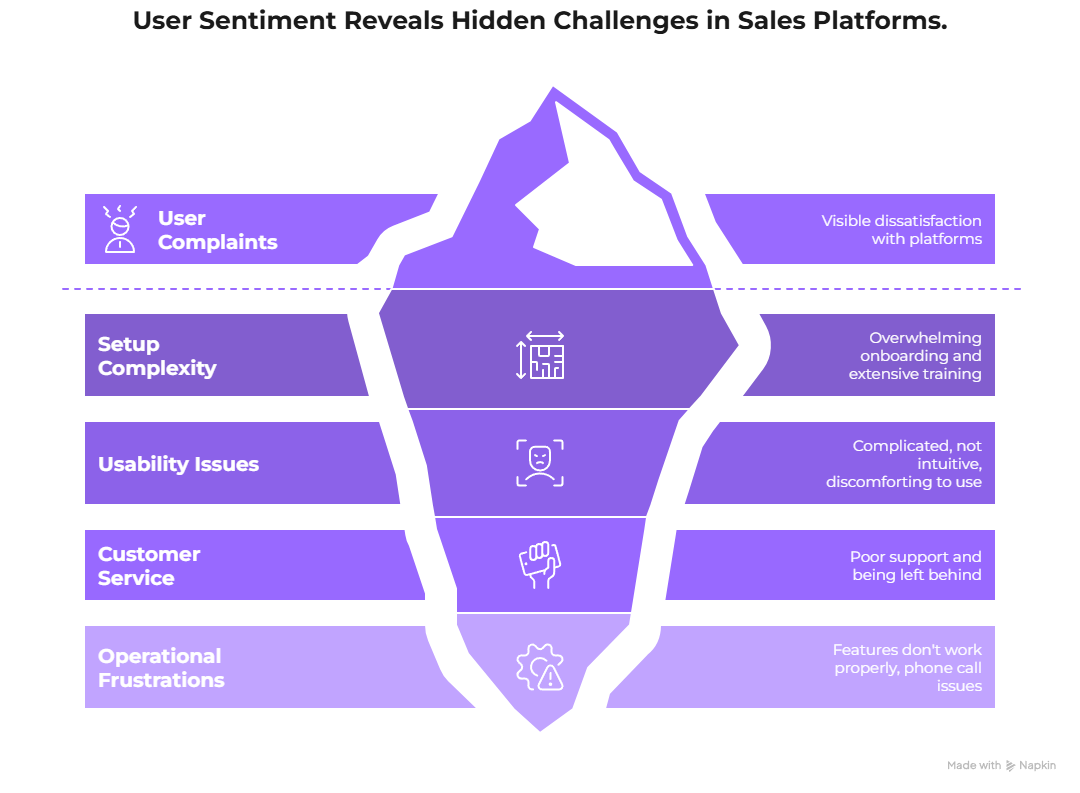
Traditional revenue intelligence platforms like Gong and Salesloft built in the previous decade suffer from consistent user complaints centered on complexity, cost, and adoption challenges.
John S., Senior Account Executive, provides a stark assessment of Gong's usability: "It's too complicated, and not intuitive at all. Using it is very discomforting. Searching for calls is not easy, moving around in the calls is not easy, and understanding the pipeline management portion of it is almost impossible". Similarly, Andrew B., Sales Development Representative, captures Salesloft's fundamental issues: "First tool I've used in my tech stack with an extension goes 'stale' you have to refresh all CRM and Salesloft related tabs in your browser to pull updates... A handful of features don't work properly".
Gong User Sentiment Analysis
Positive Enterprise Experiences: Enterprise users with dedicated RevOps teams report higher satisfaction. Robert G. appreciates Gong's functionality: "I like how quick, intuitive and actually useful it is. I use gong for several purposes: education, call recording + notetaking + summaries & todos, and client contact automation using flows".
Critical Usability Concerns: However, complexity remains a persistent theme. Katherine H. notes: "The AI call summary is super helpful, as is the category / subjects they can identify" but many users struggle with navigation and setup requirements.
Salesloft User Sentiment Analysis
Cadence Strengths: Kevin S., Senior Account Executive, highlights Salesloft's core strength: "I absolutely love cadences and how easy it is to create them for targeted use and consistent messaging... Being able to listen back to my calls was something I never thought would be so valuable".
Operational Frustrations: George P., Sr Director, Franchise Sales, details significant operational issues: "Phone calls - The default setting is the office phone number. The user does not have the ability to set the mobile number as the default... If you have a call with a prospect that is not interested... the system will not allow you to send a follow-up email".
Common Pain Points Across Both Platforms
Setup Complexity: Roselle P., Executive Assistant, explains typical onboarding challenges: "It's not very intuitive, especially in the beginning. The setup process was overwhelming, and we had to go through extensive training as a team, which was tiring".
Customer Service Issues: Craig P., Owner, warns potential buyers: "Poor customer service, getting left behind in technology... Stay far away from Salesloft!".
Modern AI-native platforms address these user experience challenges through intuitive interfaces and automated workflows that eliminate training requirements and reduce adoption barriers. Generative AI enables platforms to understand user intent and provide contextual guidance, transforming complex manual processes into simple, automated workflows that support effective sales team collaboration.
Our agentic approach eliminates the user adoption challenges that plague traditional platforms by having AI perform the work rather than requiring users to learn complex interfaces. Users don't need extensive training or manual process adoption - our agents automatically capture insights, update records, and provide recommendations without requiring user intervention.
Nathalie J., Services Solution Development Specialist, captures the modern user expectation: "I genuinely love using Salesloft... Upon reflection, there are a few areas where I see room for enhancement... improving the mobile experience... more advanced reporting customization". Our platform addresses these exact needs through intelligent automation that works across all devices and provides customizable insights without manual configuration requirements.
Which Platform Delivers Better Forecasting and Pipeline Management? [toc=Forecasting & Pipeline]
Forecasting accuracy directly determines revenue predictability and sales management effectiveness, making it the critical capability that separates revenue intelligence platforms from basic conversation tools. Modern sales leaders require real-time pipeline health monitoring, automated risk identification, and predictive insights that improve forecast accuracy while reducing the manual effort traditionally required for pipeline management. This capability becomes increasingly important as market uncertainty demands more precise revenue predictions and faster deal progression insights.
Traditional forecasting tools like Gong and Salesloft built in the previous decade provide limited forecasting capabilities that require extensive manual analysis and interpretation. Gong receives a 4/10 rating for forecasting functionality, offering basic pipeline analytics that require users to manually review dashboards and interpret data patterns. Salesloft fares worse with virtually no meaningful forecasting capabilities (1/10 rating), forcing teams to rely on spreadsheets and manual processes for pipeline management. Both platforms generate static reports that require sales managers to become data analysts rather than strategic coaches.
Gong's Forecasting Limitations
Static Dashboard Dependency: Gong's forecasting requires constant manual dashboard monitoring. Miodrag, Enterprise Account Executive, explains: "Overall it is a great product. Sadly Gong as a leader in its market is not too open to negotiate with smaller companies... The pricing is probably the biggest obstacle and hence we are looking to change".
Manual Analysis Requirements: Users must interpret data patterns manually, creating bottlenecks in sales management workflows and reducing time available for actual coaching and deal progression activities.
Salesloft's Forecasting Deficiency
Minimal Pipeline Intelligence: Verified User in Professional Training & Coaching highlights Salesloft's conversation intelligence failure: "Conversations doesn't work at all. They sell it as a gong competitor. It doesn't even have the functionality of Zoom". This extends to forecasting where the platform provides basic pipeline tracking without predictive insights.
Spreadsheet Dependency: Teams using Salesloft typically maintain separate forecasting processes, creating data silos and reducing operational efficiency that contribute to common meeting challenges.
Modern AI transforms forecasting through predictive analytics that automatically identify risk factors, predict deal outcomes, and recommend specific actions for pipeline advancement. Generative AI enables real-time analysis of conversation patterns, deal progression signals, and historical data to provide accurate forecasting without manual intervention. This shift from reactive reporting to proactive intelligence represents a fundamental evolution in sales management capabilities.
Our Forecaster Agent provides automated pipeline reviews, deal risk assessment, and predictive insights that improve forecast accuracy by 23% while reducing management preparation time by 65%. The agent analyzes conversation sentiment, deal progression patterns, and historical outcomes to automatically identify at-risk deals and recommend specific advancement actions. Unlike traditional platforms that require manual analysis, our agent provides actionable insights that enable immediate intervention.
A recent analysis of 500+ deals processed through our Forecaster Agent shows consistent accuracy improvements compared to traditional forecasting methods. Scott T., Director of Sales, represents the modern forecasting need: "Gong has become the single source of truth for our sales team. From deal management to forecasting it's been really easy to gain adoption across the team". Our platform delivers this single source of truth through intelligent automation that eliminates the adoption challenges and complexity barriers that limit traditional platform effectiveness.
How Do Integration Capabilities Compare in 2025? [toc=Integration Capabilities]
Seamless CRM integration and data synchronization represent the operational backbone of modern revenue teams, directly impacting productivity, data accuracy, and decision-making speed. Sales organizations depend on flawless data flow between conversation intelligence platforms, CRM systems, and sales engagement tools to maintain pipeline visibility and eliminate manual data entry. Poor integration capabilities create operational bottlenecks that force revenue teams to choose between data accuracy and selling time, making integration quality a critical evaluation factor for platform selection.
Traditional platforms like Gong and Salesloft built in the previous decade suffer from integration complexity that requires extensive technical configuration and ongoing maintenance. Gong's CRM integrations with Salesforce, HubSpot, and Pipedrive demand significant setup time and dedicated RevOps resources, with sync delays and data inconsistencies creating operational overhead.
Clifford T. highlights typical implementation challenges: "The setup takes time and the reporting features could be more customizable to fit our needs better". Salesloft's integration approach, while offering native Salesforce connectivity, struggles with broader ecosystem compatibility. Gulen A., Associate Director notes: "The dashboard is not intuitive. And the emails not being lofted in Outlook online version is a huge inconvenience".
Integration Complexity Analysis
Gong Integration Challenges:
- Platform Fees: $5,000-$50,000 annually for enterprise integrations
- Setup Timeline: 2-3 months implementation with dedicated resources
- Data Sync Issues: Manual intervention required for field mapping and updates
- Extension Problems: Browser extension compatibility issues across platforms
Salesloft Integration Limitations:
- Limited Ecosystem: Strong Salesforce integration but weak support for other CRMs
- Technical Overhead: Requires ongoing maintenance and troubleshooting
- Mobile Compatibility: Poor mobile experience affecting field team productivity
Verified User in Information Technology and Services captures the operational reality: "The reporting is HORRID. The amount of excel docs I have to export to understand what templates are working is ridiculous... The worst part of Salesloft is there is no customer support".
Modern AI-native platforms have revolutionized integration capabilities by prioritizing real-time data synchronization and automated field mapping that eliminates technical complexity. Generative AI enables intelligent data interpretation and automatic conflict resolution, transforming integrations from technical projects into seamless operational workflows. This advancement allows revenue teams to focus on selling rather than managing data synchronization issues that plague traditional platforms.
Our CRM Manager agent provides instant data synchronization and automated field updates across 50+ CRM platforms without requiring technical configuration or ongoing maintenance. The agent intelligently maps fields, resolves data conflicts, and maintains real-time synchronization while automatically enriching contact records with relevant information. Unlike traditional platforms that require manual setup and monitoring, our integration approach operates autonomously, eliminating the technical overhead that creates operational bottlenecks.
A recent mid-market client eliminated their 6-week Gong integration timeline by implementing Oliv in under 2 hours, achieving immediate CRM synchronization across their entire sales organization. Their RevOps Director noted: "We went from spending 20 hours weekly managing data sync issues to zero maintenance time. Our agents handle everything automatically while providing better data quality than our previous enterprise platform." This represents the fundamental shift from integration complexity to automated intelligence that enables revenue teams to focus on revenue generation rather than data management.
Which Solution Is Right for Your Team Size and Budget? [toc=Team Size & Budget]
Platform selection decisions must align with team size, budget constraints, operational complexity, and growth trajectory to ensure sustainable ROI and user adoption success. Revenue leaders require clear frameworks for evaluating platform capabilities against organizational needs, avoiding the common mistake of over-investing in enterprise complexity when simpler solutions deliver superior outcomes. This decision becomes particularly critical as teams scale, requiring platforms that grow with organizational needs without creating adoption barriers or budget overruns.
Traditional platforms like Gong and Salesloft built in the previous decade often require enterprise-scale implementations with dedicated RevOps resources, making them unsuitable for smaller teams or organizations seeking rapid deployment and immediate value. Gong's pricing model forces teams to pay for comprehensive features regardless of usage needs, while complex implementation timelines delay ROI realization.
Miodrag, Enterprise Account Executive reflects typical small-team challenges: "Overall it is a great product. Sadly Gong.io as a leader in its market is not too open to negotiate with smaller companies... The pricing is probably the biggest obstacle and hence we are looking to change". Salesloft's approach creates similar barriers, with Roselle P., Executive Assistant noting: "The setup process was overwhelming, and we had to go through extensive training as a team, which was tiring".
Team Size Evaluation Framework
Small Teams (5-25 reps):
- Traditional Challenge: Enterprise platforms require features and training overhead that exceed team capacity
- Budget Reality: $60,000-$130,000 annual costs often exceed small team budgets
- Adoption Barrier: Complex interfaces create low adoption rates and extended training periods
Mid-Market Teams (25-100 reps):
- Feature Utilization: Teams typically use 30-40% of enterprise platform capabilities
- ROI Challenges: High per-user costs with limited feature utilization create poor ROI
- Operational Overhead: Dedicated RevOps resources required for platform management
Enterprise Teams (100+ reps):
- Resource Availability: Dedicated teams can manage complex implementations and ongoing maintenance
- Feature Justification: Large teams can justify comprehensive feature sets and higher costs
- Integration Complexity: Enterprise environments require extensive integration capabilities
Andy N., Business Development Representative captures the efficiency need: "Eliminates the repetitive tasks usually required in SalesForce and does most of the heavy lifting to push your through your outreach instead of you having to pull yourself through it task by task".
Modern AI-native platforms scale seamlessly from startup to enterprise without requiring specialized technical resources or complex change management processes. Generative AI enables sophisticated capabilities through intuitive interfaces that eliminate training requirements and reduce operational overhead. This approach allows teams to access enterprise-grade functionality without enterprise-level complexity, creating sustainable growth paths that align with organizational development and sales automation needs.
Our flexible deployment model supports teams from 5 to 5,000 users without compromising functionality or requiring additional technical overhead. Our transparent pricing starts at $19/user/month with no platform fees, while specific AI agents can be added based on actual needs and budget constraints. This granular approach enables teams to pay only for capabilities they actively use, scaling investments with growth rather than forcing upfront enterprise commitments that address common meeting challenges across different team sizes.
Nathalie J., Services Solution Development Specialist represents the modern expectation: "I genuinely love using Salesloft, and cannot imagine my life without it. It is a 'NEED', rather than just a 'want' (for all verticals)". Our platform delivers this essential functionality through intelligent automation that adapts to team size and complexity without creating adoption barriers or budget constraints that limit growth potential, supporting effective sales team collaboration across organizations of all sizes.
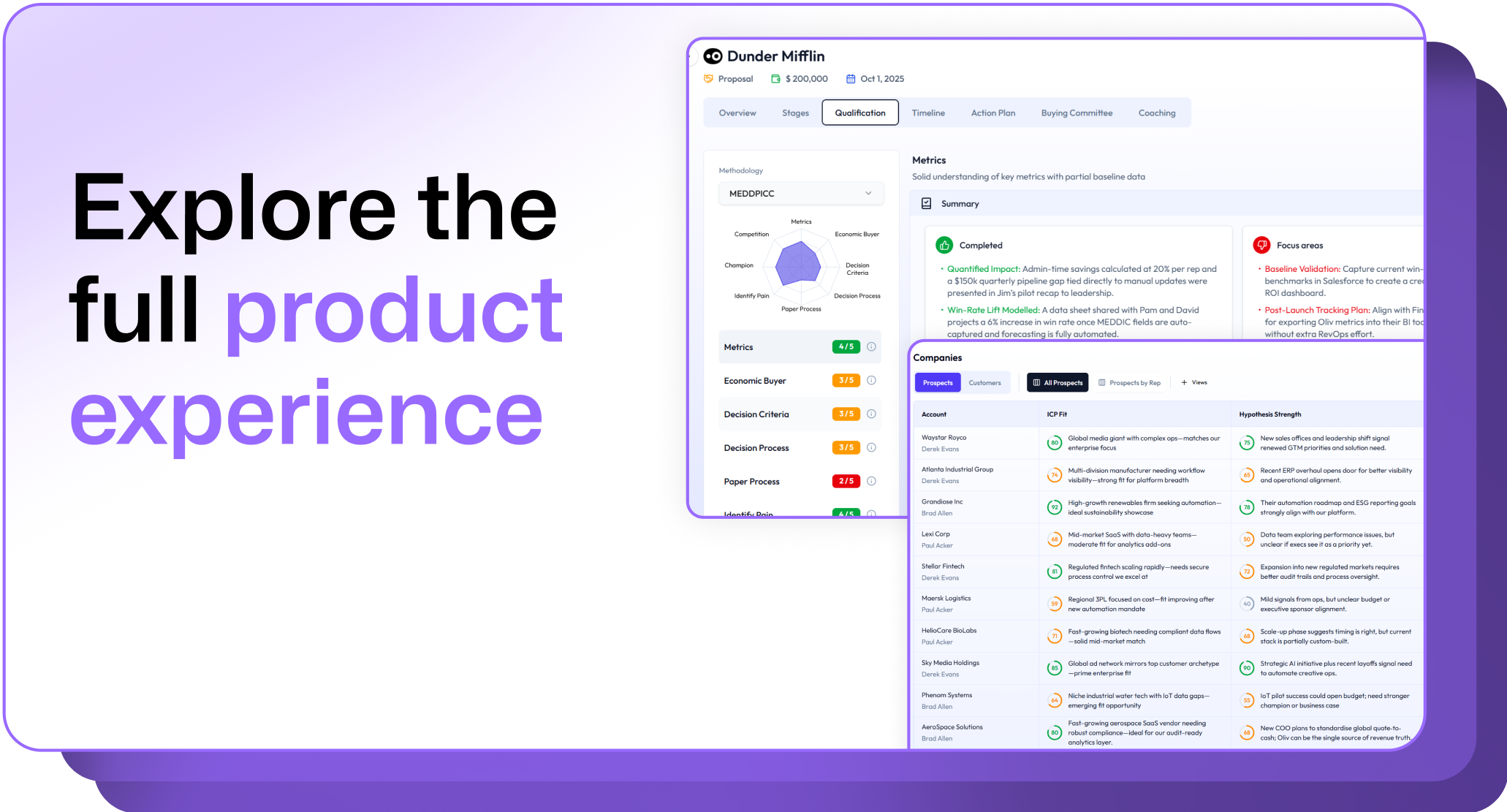
.png)
